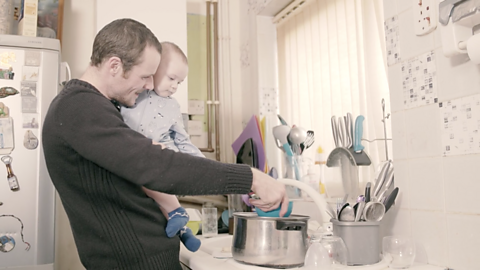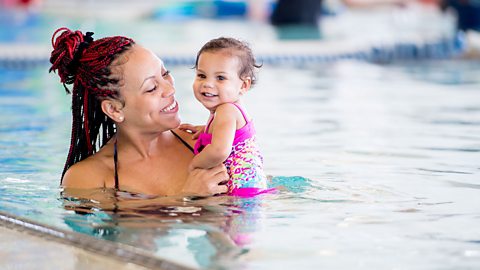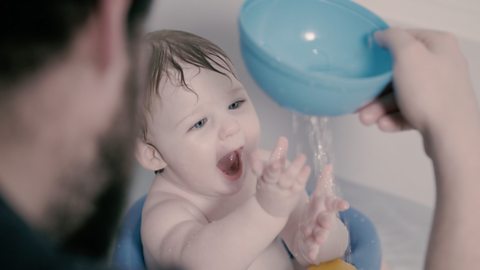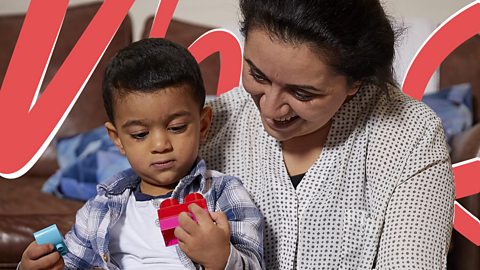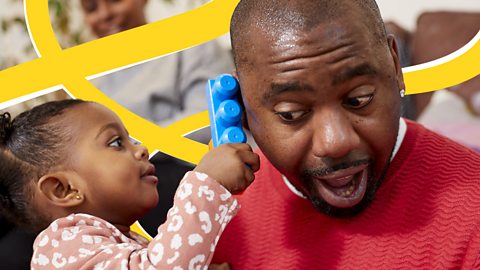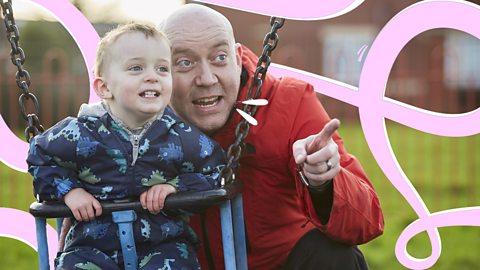Home > Tips and advice > Play
Splashing in puddles, pouring water in and out of cups, jumping into a swimming pool, or getting soaked in a water fight – children love water! And when they are playing with water, they are also experimenting and learning about the world.
From baby’s first bath time, to looking at reflections in puddles with your 4 year old, here are some ways you can help your child’s talking and understanding while you play together. Be prepared to get wet!
Playing with babies
Bath time is a special bonding time for you and your baby. Talk or sing to your baby during bath time in a quiet, soothing voice and they’ll learn it’s getting close to bedtime. If your baby makes happy noises, copy them. If they’re learning they can move their arms and legs, and it results in a splash, share their surprise and enjoyment! You could also gently splash the water next to them.
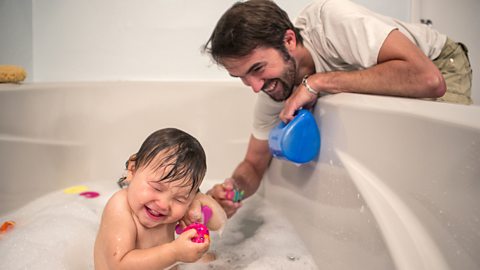
If your child is starting to enjoy bath time as a play time, you can play ‘peek-a-boo’ with a bath duck (or any other toy). Hold it under the water, say ‘where’s duck?’, then let it go. Your baby will love watching it pop back up. If they show you that they want you to do it again in any way - maybe with a look, by pointing, or making a noise – they are starting to communicate!
“Splash”, “drip”, “woosh”… Water play is a great opportunity to add in sound effect words. These words are easier for children to learn and understand, and could be a stepping stone to your child’s own first words.
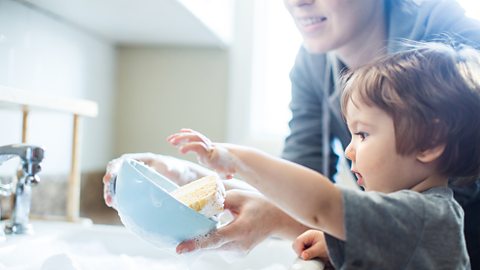
Playing with toddlers
In the bath, teach your child the names for parts of the body as you wash and dry them. Or if you want to mix up the routine, put bubbles on their nose, chin, arms… you could even have fun making hats and beards out of them.
Plastic cups or pots can provide endless fun at this age. Fill them up and pour the water from one to the other, or back into the bath if that’s where they are. This is early experimentation – your child is learning how the water moves, and how their actions make different things happen. Instead of telling them what to do, or playing in a different way next to them, take time to watch what they are doing.

Use simple words to talk about what they’re doing when they look to you to join in the play. “Full” and “empty” will probably be too hard for your child to understand at this age, so here are some ideas of simpler things to say:
- Action words such as “pour”, “splash”, “wash”, “squeeze” and “pop”
- Describing words such as “more”, “in”, “out”, “wet” and “dry”
If it’s a rainy day, nature provides the water! The classic game of jumping in puddles gives chances to learn describing words like “clean”, “dirty”, “wet” and “dry”. Don’t fancy going outside? Sitting together, watching the rain running down a window can be surprisingly calming, and you can spot “fast” and “slow” raindrops.
Playing with older pre-schoolers
Washing up might be a chore for us, but it can be great fun for little children. Put a washing up bowl on the floor for them or use a child’s step to help them reach the sink, then give them some plastic pots, kitchen items, and let them ‘wash up’. Ask them to talk about what they are ‘cleaning’ and what they have ‘cleaned’ (or you could say ‘washing’ and ‘washed’), for example “I cleaned the spoon. Now I’m cleaning the plate”. You could then do the same with “drying” and “dried”. They will start learning how to talk about things that have already happened, as well as what they are doing now. They’ll also be really proud of themselves for helping out!
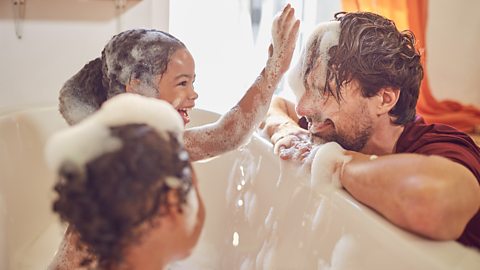
At this age, your child might enjoy some of these water experiments:
- Watching reflections in puddles, or in a saucer or bowl of water. What happens if you drop in a small stone?
- Seeing which objects float and sink in a bowl of water. When they’ve found something that floats (like a plastic lid), can your child add other objects on top of it (such as a tea spoon, or a small plastic toy), and then see if it still floats?
- Spraying water on to the pavement or another hard surface outside. What happens if it’s a sunny day? What happens if you spray water onto a wall instead of the floor?
Ask your child to tell you what they did and what happened. You can help them by asking them what they did ‘first’, ‘next’ and ‘then’… If they can do that, they could try having a guess at what might happen if you make a small change, such as putting a heavier object on the floating lid. Talking about their experiences and making predictions are useful communication skills children are developing around this age.

Some children might want to play or experiment with water, but are a bit unsure about getting wet. If this is the case, you could put water in a plastic bottle, with a bit of colouring (or squash), and maybe some small items like beads. Make sure the lid is on firmly, then let your child explore it. They can shake it, tip it slowly, roll it, and then watch and listen to what the water does. When they’re ready, they could ask you to open and pour the water into another bottle or tub. Make sure you supervise your child at all times, particularly if you are putting anything that can’t be eaten into the water bottle.
If you try any of these activities, we hope you and your little one have a splashing time!

